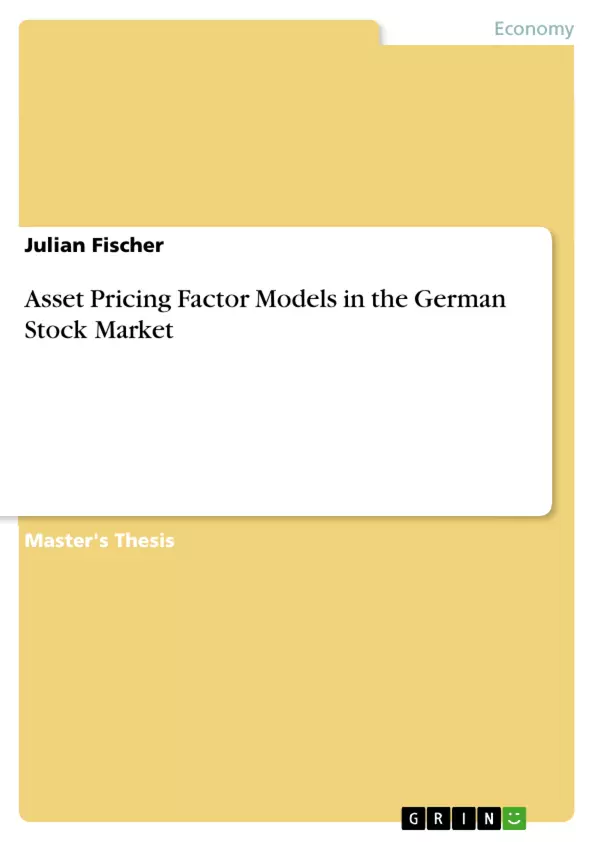In this paper, we examine how various modern multifactor models, such as the Carhart factor model, five-factor model and its complement six-factor model by Fama and French, the q-factor model by Hou, Wue and Zhang, and the mispricing factor model by Stambaugh and Yuan perform in the German stock market. It is discernible that, depending on the application model, like factor spanning tests, different sortings, return anomalies, sector- and equity fund investigation, they often provide quite similar explanatory power, while in individual cases sometimes one and sometimes the other model performs better. The underlying factors contribute differently to the explanatory power depending on the time period. Thus, in case of doubt, the six-factor model is preferable, as it is the most versatile model.
Since the establishment of the capital asset pricing model as a cornerstone of modern capital market theory in the 1960s, new investigations and studies have been built on this model on an ongoing basis. This continuously leads to extensions and modifications of the asset pricing models since then. These models can be used in various ways, for example to explain the pricing of risky financial assets under restrictive assumptions or to gain important insights into the relationship between expected return and risk of securities. These can be used in various ways, for example to explain the pricing of risky financial assets under restrictive assumptions or to gain important insights into the relationship between expected return and risk of securities. In this paper, we aim to answer the overarching research question of how modern asset pricing models perform for the German stock market. For this purpose, we first discuss the characteristics of the German stock market, followed by the milestones of the development of factor models, their empirical evidence and their factors, as well as internationally known return anomalies. In the subsequent part, five modern asset pricing models are tested in different scenarios of the German stock market, including factor spanning tests, different sortings, anomalies, sectors and in equity funds. For this purpose, various analytical methods are used and performed with the software “Stata”. Finally, the comprehensive results are summarized and concluded.
Inhaltsverzeichnis (Table of Contents)
- 1. Introduction
- 2. Fundamental theory and previous discoveries
- 2.1 Relative classification of the German stock market in an international context
- 2.2 The Evolution of Factor Models
- 2.3 Model accuracy and empirical evidence of factor models.
- 2.4 Empirical significance of the established factors....
- 2.5 Global and Germany specific return anomalies...
- 3. Structural analysis of the German stock market..
- 3.1 Basic characteristics and statistics.......
- 3.2 Factor spanning tests
- 3.3 Analysis of 3 x 3 sorting ..
- 3.4 Analysis of 2 x 2 x2 sorting.
- 4. Analysis of anomalies in the German stock market............
- 4.1 Descriptive statistics and significance of prominent anomalies.....
- 4.2 Multifactor regressions of prominent anomalies .......
- 4.3 Out-of-sample analysis of the net payout yield anomaly.
- 5. Sector analysis of the German stock market.......
- 5.1 Descriptive statistics of sectors
- 5.2 Multifactor regressions for relevant sectors....
- 5.3 Rolling window regressions of two relevant sectors..
- 6. Fonds analysis of the German stock market
- 6.1 Descriptive statistics of active and passive managed fonds...
- 6.2 Multifactor regressions of six representative fonds
- 6.3 Out-of-sample analysis of six representative fonds..
- 7. Conclusion........
Zielsetzung und Themenschwerpunkte (Objectives and Key Themes)
This master's thesis examines the validity of established asset pricing factor models in the German stock market. It aims to explore the relevance of traditional and more recent factors in explaining the cross-sectional return variability of German stocks. The research investigates the empirical significance of these factors in capturing market anomalies and sector-specific return patterns.
- Evaluation of asset pricing factor models in the German stock market
- Analysis of the impact of various factors on stock returns
- Investigation of return anomalies and their explanatory power
- Exploration of sector-specific return patterns and their relation to factors
- Assessment of the performance of actively and passively managed funds in the German market
Zusammenfassung der Kapitel (Chapter Summaries)
The thesis begins with a thorough introduction to the field of asset pricing factor models. It explores the historical development of these models and examines existing research on their effectiveness. Chapter 2 delves into the theoretical framework and analyzes the classification of the German stock market in a global context. It further investigates the evolution of factor models, their empirical evidence, and the significance of established factors. Chapter 3 conducts a structural analysis of the German stock market, including basic characteristics, factor spanning tests, and sorting analysis. This chapter aims to establish a foundation for further investigation of return anomalies and sector-specific patterns. Chapter 4 focuses on the analysis of return anomalies in the German market, examining their descriptive statistics, conducting multifactor regressions, and performing out-of-sample analyses. This analysis provides insights into the predictive power of the identified anomalies. Finally, Chapter 5 delves into sector analysis, examining descriptive statistics, multifactor regressions, and rolling window regressions for specific sectors, highlighting the impact of factors on sector-specific returns. The thesis excludes any information from the conclusion and final chapter to avoid revealing major conclusions or spoilers.
Schlüsselwörter (Keywords)
Asset pricing factor models, German stock market, return anomalies, cross-sectional return variability, multifactor regressions, sector analysis, active and passive funds, out-of-sample performance, value, momentum, profitability, investment, size, liquidity, net payout yield.
- Citation du texte
- B.A. Julian Fischer (Auteur), 2021, Asset Pricing Factor Models in the German Stock Market, Munich, GRIN Verlag, https://www.grin.com/document/1023138



